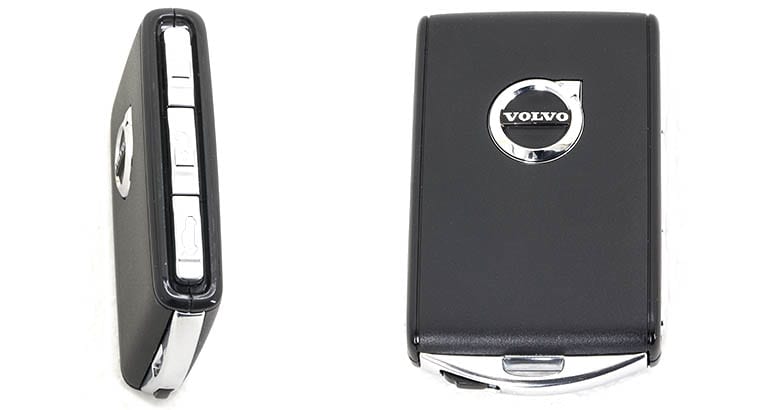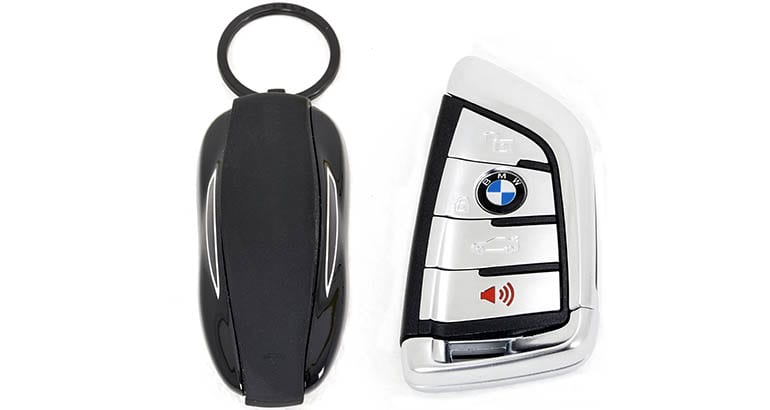Lower All Windows Instantly: One of the more common hidden functions on many of today’s key fobs is the ability to roll down all the windows and open the sunroof at the same time by pressing a single button. It’s handy, and it helps cool off the car on a hot summer day. It’s not often labeled on the fob, though, so the owner needs to know the button sequence.
On most cars that have the feature, it’s accomplished by pressing the unlock button on the key fob once, then pressing it again (within 10 seconds) and holding it down until all the windows are opened.
Remote Start: On most key fobs, the remote engine start button is labeled with a circular arrow (but often not the words “remote start”). Typically, the owner first hits the lock button, followed by a press of the remote-start button. On other remotes, drivers must press the circular arrow button twice (indicated by a “2x” or “x2”).
But on some new BMWs, the optional remote-start function is completely hidden. Owners can launch the engine for a limited time by pressing the lock button on the key fob three times within one second.
Mirror Folding: Some cars automatically fold in the side mirrors as part of the door-locking process. With others, this feature is optional, and the owner needs to know how to use it.
For example, on newer Chevrolet and GMC pickups equipped with remote mirror folding, the owner holds the key-fob lock button for a full second to make the mirrors fold in. This is a handy feature when parking on city streets or in a narrow alley, given how large pickup-truck side mirrors are.
Vehicle Summon: The Tesla Model S and Model X key fobs—which look like a miniature car—don’t have any labels, belying their many uses. One of those is the Tesla Summon function, which moves the car in and out of tight parking spaces while the driver stands outside the car.
Before using Summon, owners must first enable the system using the vehicle’s center screen. This needs to be done only once.
To activate Summon, press the button in the center of the fob—or roof of the mini-car—until the hazard lights flash. Then, if you want the car to pull forward, press the button on the front of the fob (it looks like the hood of the mini-car). To stop its progress, press that same button again. The car can also go backward by following a similar procedure. Press the roof of the car, and once the hazard lights have flashed, press the button on the back of the fob (or where the trunk would be in the mini-car). Again, once it has gone far enough, press that button a second time to stop the car’s motion.
Tesla Model X owners also might not realize that pressing the top of the key fob closes any opened doors—front, rear, or liftgate—all at once.
Mechanical Key: Owners of cars with push-button start systems might not be aware that a mechanical key resides inside the key fob. This is so that owners can still unlock the driver’s door in cases when the car’s battery or the key fob’s battery runs out of juice, or the fob malfunctions. The key is typically accessed by pushing a button on the key fob and pulling the key out, although on some remotes, the release isn’t obvious.
Some cars have an obvious key slot on the door handle; on others, it’s hidden behind the door handle (visible when you pull the door handle out). Still others require removing a plastic cap next to the door handle to reveal the key slot underneath.
The Downside of Key-Fob Secrets
The presence of hidden buttons and functions means that owners need to be aware in order to avoid problems.
For example, while it’s cool to be able to lower all the windows via the key fob, it’s not funny when this happens accidentally—especially during a rainstorm or when a car is covered in snow. This can happen if the key fob is activated accidentally while at the bottom of a purse or sitting in a pants pocket.
This happened to a CR auto editor who walked out to our Honda Accord test car one morning and found all the windows down and the sunroof wide open. Fortunately, it had been a dry night and nothing had been stolen from the car.
A Honda spokesman, Chris Naughton, told us that “unintentional activation is very uncommon, but would be equally possible with other functions, like remote start, or the panic alarm.”
One of CR’s testers was recently surprised to return from an errand to find to our 2019 BMW X5’s engine running. In making sure that the car was locked as he walked away, he evidently hit the lock button on the key fob three times quickly, not realizing that this specific sequence would activate the BMW’s remote-start system. That’s a potentially dangerous situation. Carbon monoxide could have built up if this happened in a closed garage.
But the X5’s remote-start system is designed to shut the engine off after about 15 minutes of running while parked, according to the automaker.
“The recommended way of operating the remote-start system is via the BMW ConnectedDrive smartphone app, which can be performed from any range as long as the phone has reception,” said Oleg Satanovsky, BMW’s product and technology spokesman.
The difference between BMW’s key-fob deployment vs. most other carmakers’, though, is that the X5 doesn’t have a specific button for the remote-start system. It’s a matter of space, according to Satanovsky. The limited surface area of a remote key precludes an additional engine remote-start button, he said.
Still, the automaker should do more to make owners aware, says Kelly Funkhouser, CR’s vehicle usability program manager.
“If BMW didn’t want to put a dedicated button on the key fobs of vehicles equipped with the optional remote start like most car makers do,” she says, “then there should be an indication on the lock button that it has remote-start capability.”
Automakers try to make fobs useful and unobtrusive, and that contributes to the problem, says Sam Abuelsamid, senior analyst at the automotive research firm Navigant.
“The fundamental problem here is that the key fob is, ideally, reasonably small,” he says. “Unfortunately, like other small devices such as smartwatches, that means you have limited space for both controls and labels.”
Abuelsamid says that it’s a challenge for automakers to get owners to study up on what their fobs can do.
“Personalization of some manufacturers’ key fobs is another area that many customers may not realize they have,” he says. “If there are multiple users of a vehicle in a household, each [driver] can have their own fob, and once they set things like seat and mirror positions, the car will automatically adjust those as you approach the vehicle. For homes with young drivers, this can be used to limit certain functionality, such as top speed and preventing the disabling of driver assist features.”

WHAT YOU CAN DO
When you get a new car, read the specific sections of the owner’s manual that cover the fob. If it’s possible to do so, configure the settings on your remote to lock out any features you don’t want to accidentally set off.
Owners should also read the car’s quick reference guide, which covers highlights from the owner’s manual. Many new cars have them. Sometimes the basic features of the key fob are covered here, and it’s usually a much shorter read than the owner’s manual.
What Car makers Can Do
Keyless entry systems allow owners to almost ignore their key fob when it’s in a pocket or purse. Doors automatically unlock when the driver approaches or grabs a handle, and the car starts with the push of a button. No fob interaction is needed.
But there are still times when people have to press buttons on the key fob, such as when they’re searching for their car in a crowded parking lot. Other people just simply prefer to use the key fob out of habit.
“Key fobs need to be labeled more clearly, regardless of whether they have hidden tricks or not,” says CR’s Fisher. “It’s hard to even tell the difference between ‘lock’ and ‘unlock’ on some key fobs, especially at night.”
Our testers have found that key fobs in newer Kia and Volvo models in particular suffer from this problem because of their small, hard-to-decipher buttons placed along the side of the key fob.
When asked about Volvo’s key-fob design, a company spokesman, Russell Datz, told us that the buttons were placed on the side “to reduce the possibility of unintended activation, such as when they’re in a pocket or purse.” But aesthetics were also a factor, Datz said. “There is some Scandinavian design influence to give the fob a clean and simple appearance.”
Abuelsamid admits that automakers are in a tough spot attempting to please everybody, but says “designers and engineers should worry less about the key fob doing everything and focus more on a consistent and easy user experience without any surprises.”
In the future, the point may become moot as smartphones take over these fob functions, Naughton says.
“As the industry moves toward smartphone app-based vehicle controls such as AcuraLink, some of these functions will move into those rather than existing through the key fob,” he says. “For now, though, we cannot make it too difficult to activate the functionality or no one will likely use it or even be able to figure it out. Automotive design is about balancing potential misuse with ease of use.”
























